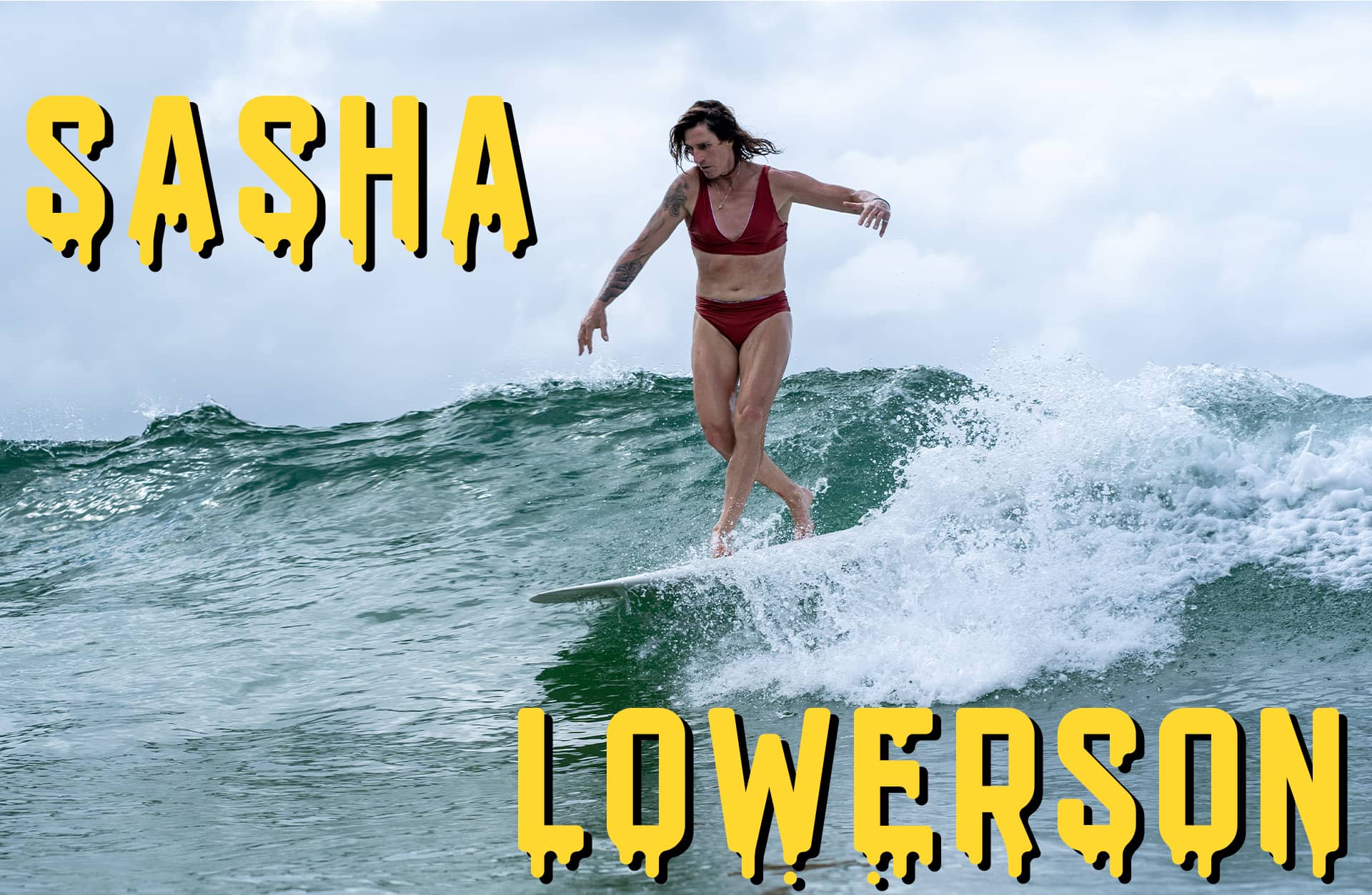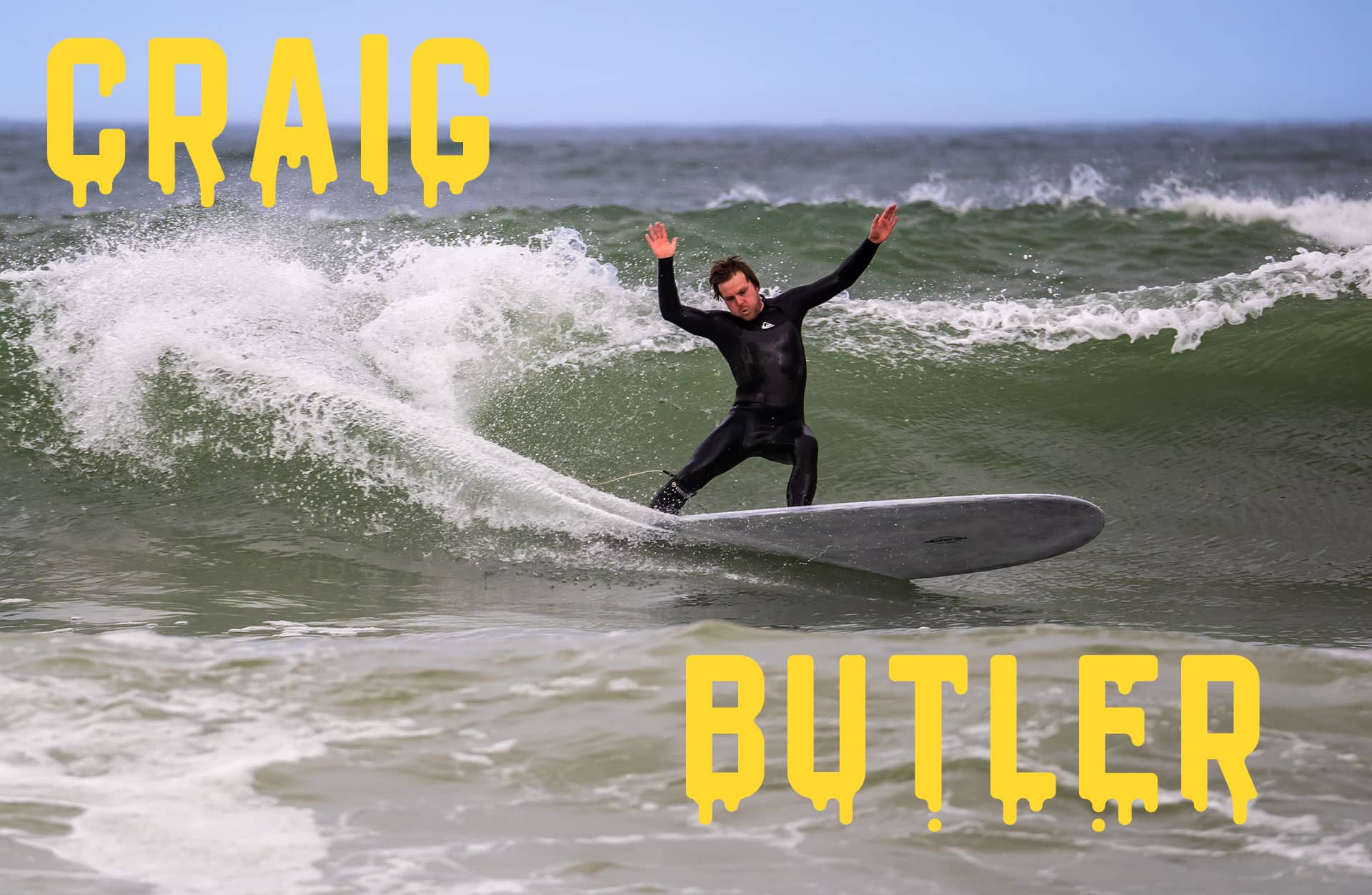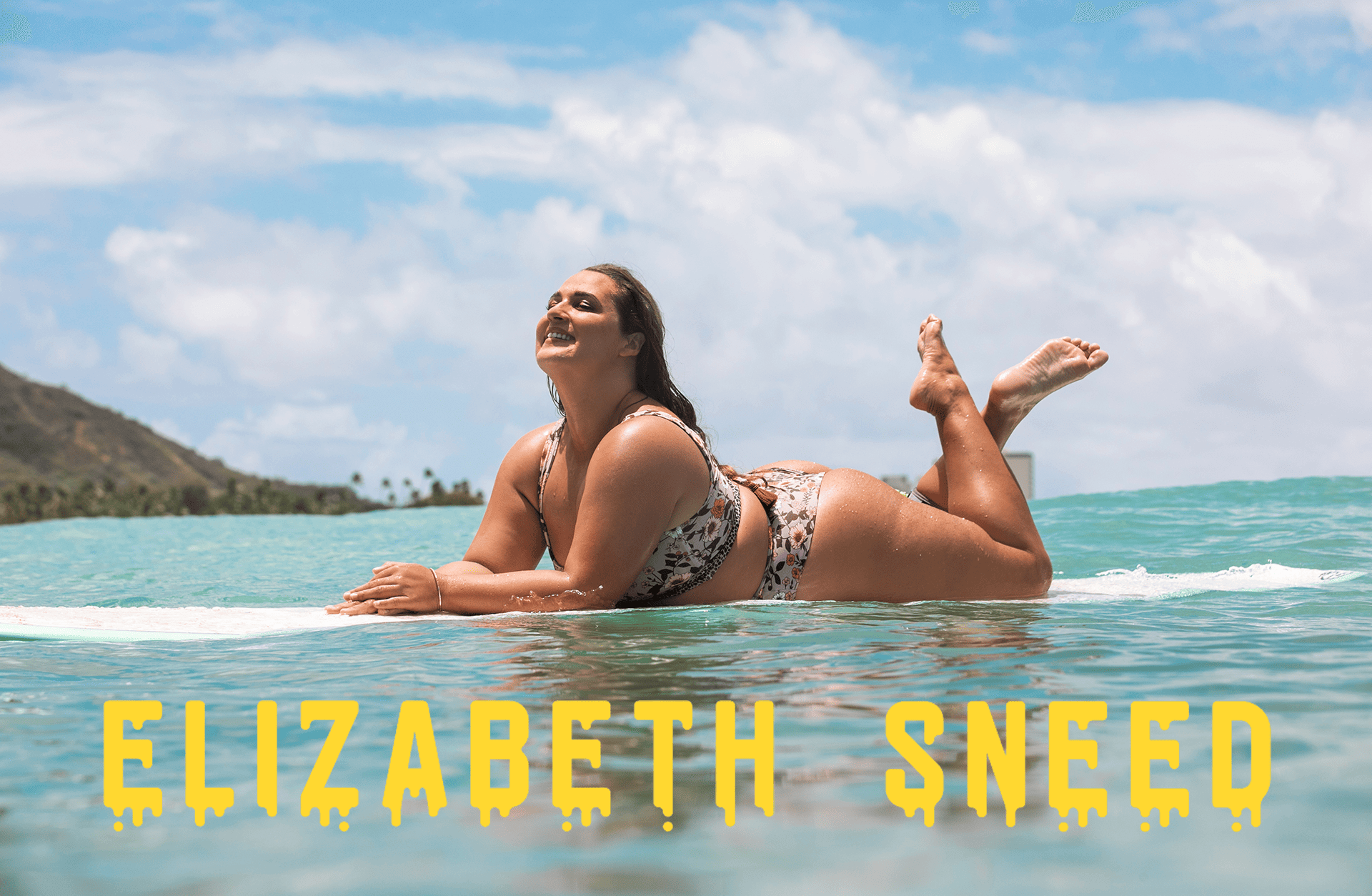SURF // 01 SEP 2022
FREEDOM IN THE WAVES
TW: Sensitive Content on Suicide
On May 15th, 2022, history was made on the West Coast of Australia when 43-year old surfer, Sasha Jane Lowerson, became the first trans-woman to claim a title at a surfing competition. Hosted at her local line up, the West Oz Longboard & Logger State Championship, Lowerson looked right at home in the long running left waves, showing off her full repertoire of footwork. However, Lowerson’s victory dredged up the transphobia that lingers just beneath the surface of the surfing community. “I had a few of the pro men commenting on my inclusion on a few of the Instagram and social media posts that big magazines would put up,” recalled Lowerson. “The comments are disgusting.”
Raised in Australia, surfing was a rite of passage for Lowerson. “I grew up pretty close to the beach and it was my escape. It was my little place of freedom,” she smiled. Navigating through childhood, Lowerson could tell that she felt a bit different from the other kids, but in an era that lacked inclusive language or even accessible education around the trans experience, she was unable to quantify what she was feeling. But Lowerson found great comfort out in the water. “In the waves there’s no gender,” she laughed. “The waves don’t judge. They just let you do you, and ride its energy. So that’s where I found my solitude.”
While the physical act of surfing provided Lowerson a respite and a way to express herself, it was a double-edged sword, with the flip side being surf culture. “Yeah, it definitely wasn’t a safe place to express your femininity, that’s for sure,” explained Lowerson. “It was probably the one thing that kept me from going through with the early day transition attempts, the unaccepting nature of the surf industry and community at that point. So, as much as [surfing] was a blessing, it was a curse as well.”
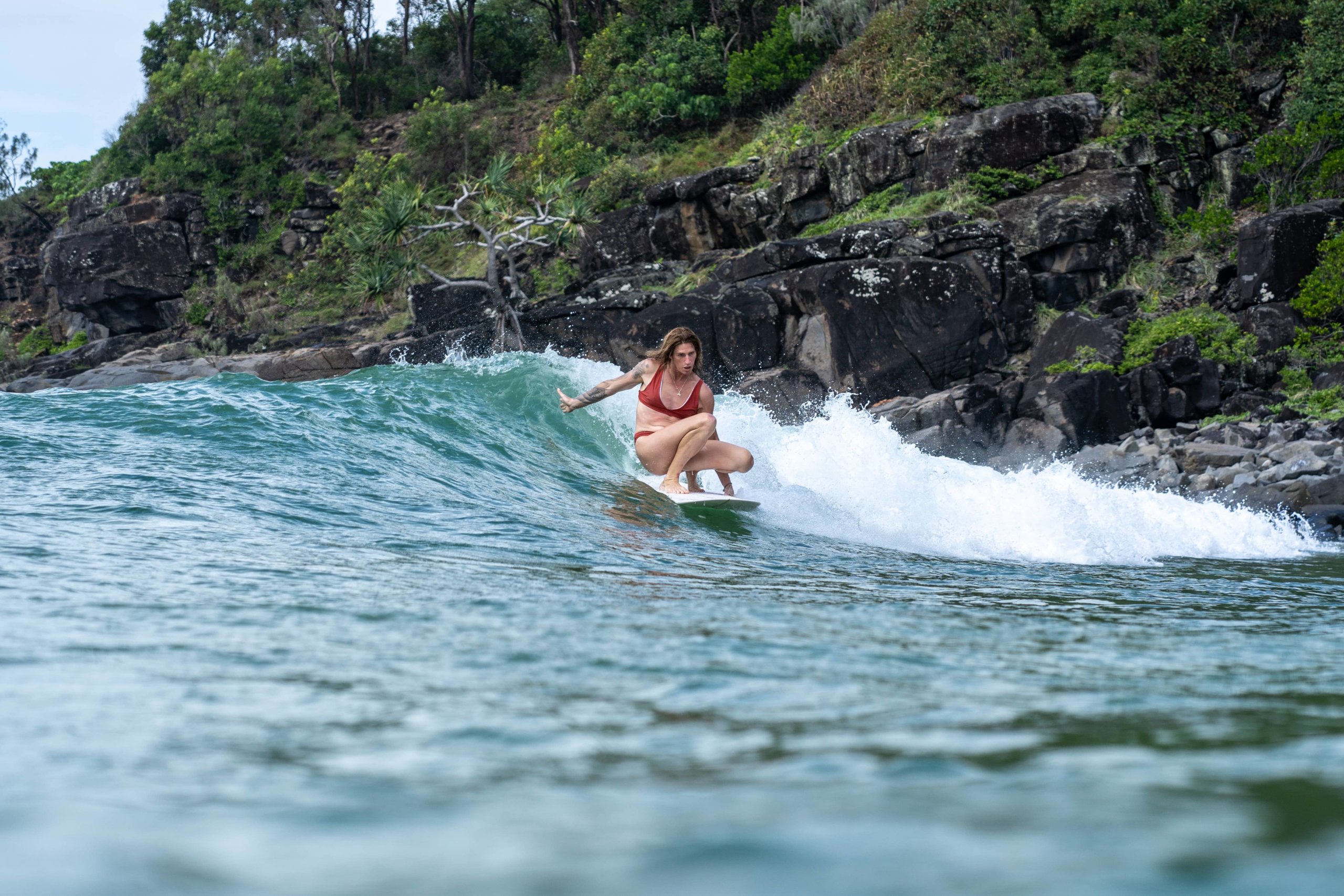
So much a curse that the first time Lowerson tried to transition at 19 years old she planned to leave surfing entirely. But she couldn’t leave, stuck in a tug-of-war between passion and self throughout her twenties. With each tug, she felt like she was losing ground, sacrificing one side of herself to help bolster the other. During her late twenties she tried to transition again, but found herself trapped by a sport whose community might not love her back. After decades of conflict, Lowerson finally hit her limit.
“I’m pretty good at a lot of things, but not real good at others. Suicide is, luckily for me, one of the things I’m really shit at,” she laughed. “If I was really good at it, we wouldn’t be here now having this conversation because I had so many attempts.They all stemmed from me not being able to be me and the fear, just the crippling fear and the mental abuse that I put myself through by putting up these barriers thinking that it was not possible [to be me].”
[If you struggle with thoughts of suicide please see resources at bottom of page for support]
Though fully determined to begin her transition process, Lowerson hesitated to re-introduce herself to the surfing community. “The six months out of the water was because of fear and not wanting to be out in my community,” explained Lowerson. “I actually waited well over twelve months before competing again. I took a fair bit of time just working myself out and spending a lot of [time on] self love days, really just finding my own self and where I was and what I wanted to do and whatnot. [Then,] I started surfing again and it was just free surfing.”
Having competed pre-transition, Lowerson wanted to make herself 100% visible in the surf community and reached out to Surfing Australia, the governing body of surfing in Australia, to update them on her status. “At that point, I wasn’t even thinking about competing,” she laughed. Along with updating Surfing Australia, she added in her message, “I’ve noticed that you guys don’t have a policy for community inclusion. I think you might want to think about doing something about that, if you want to have a chat.”
And thus Surfing Australia’s “Policy for the Inclusion of Transgender and Gender Diverse People in Community Surfing” was created. “They really did well with their language and their inclusion at [a competitive] level,” smiled Lowerson. However, the policies set forth by Surfing Australia are limited at an elite level since they are governed by the International Surfing Association (ISA) and ultimately the International Olympic Committee (IOC). In previous years, trans-athlete’s ability to participate in Olympic events was based on their testosterone levels, but as of this year that will change. Guidelines will instead be determined by each sport’s international guiding body. Anticipating drastic changes in the coming year, Surfing Australia had their hands tied when creating their current policy draft. As Lowerson said, “They’ve got their steps that they’ve got to take and they are baby steps.”
“Being progressive hasn’t really been something that Australia has ever really sort of led the way in. Now we are surprisingly leading the way in gender diversity within surfing. It is quite a proud moment for surfing in the queer space. So, that was pretty cool to be a part of that. It’s been a real highlight, to be honest.”
“They had to vote these policies in too. It was a really scary moment. I remember being told, it’s got to get voted in by the board, and I’m thinking to myself that this could all just fall over. But, funny enough, that came back, and from my understanding, it was voted in unanimously. There wasn’t a single ‘no’ across the board. There’s a few girls here in the surfing fraternity that have been really, really working hard behind the scenes to make it fair for all athletes, not just myself, but all the girls involved.”
With the new policies in place, competitive surfing was once again a possibility for Lowerson. Having already gone through the coming out process to her local surf community, a return to the competitive surfing community was a brassy decision that Lowerson knew would cause backlash. “There needs to be those awkward conversations,” said Lowerson, explaining her motivation. “There needs to be visibility for the youth and it needs to be known that it’s okay, it’s okay to be you. There’s a saying that women use in women’s sport and I attach myself to that because I’m a strong female athlete, and it’s that you can’t be what you can’t see.”
Determined to be the representation she longed for in her childhood, Lowerson entered the Noosa Festival of Surfing in March 2022. Lowerson described her first time competing with other women as, “scary as shit.” She continued to explain, “there were a lot of things that I took away from that event that I didn’t learn straight away. I’ve just learnt them by what I put myself through. I felt like when I was there that I had to defend and justify myself for being there. So, I went through a lot of conversations that were very emotionally taxing and very draining when you’re actually there to compete.”
Exhausted by both Hormone Replacement Therapy (HRT) and the constant need to validate her presence, Lowerson wasn’t able to perform her best and lost in the quarterfinals. Not a novel performance, but still a historic moment as it was the first time a trans woman participated in a surf competition. The event was not widely reported, yet Lowerson still faced transphobia within the local surf community. Reflecting on her experiences at Noosa, she shifted her mindset. “I got to this moment where I went, go to this next event and just be you, go as a competitor, you’re just another girl. You’re just another girl competing and just be that girl and let your surfing do the talking. I’m okay with your opinion if you don’t agree with what I’m doing. But guess what? Your opinion doesn’t matter because there’s a rule saying that I’m allowed.”
The indignation from the surf community and general populus following the West Oz Championship was anticipated and Lowerson has patiently worked her way through transphobic comments, churlish articles, and even ignorant remarks from well-intentioned supporters. Lowerson laughed, “The classic one that I’ve received is, ‘oh, I 100% support Sasha in her transition, but just not in sport.’ So what part of 100% are you at?”
Those who oppose Lowerson’s participation in surf events all cry the same recycled rhetoric. There are claims of unfairness because of Lowerson’s alleged biological advantage from going through a testosterone driven puberty. “The journalists will sit [and ask me], for a biological male like yourself, how do you feel? And I’m like, well, how do you know? Are we about to have an intersex education moment?” laughed Lowerson. “Sorry, excuse me, we’re not going to assume here. How do you know I’m biological male? Are you a doctor now? Did we go do some chromosome tests and some hormone tests? How did you actually check my genitals?”
At the time of Lowerson’s victory, a poll conducted by Stab Mag on their Instagram showed 73% of people did not believe that trans-surfers should be allowed to compete in their identified gender category. Alongside this statistic, Stab Mag also reported that their Instagram audience is just over 81% male identifying. When the loudest voices come from those least impacted, it becomes clear that the controversy around trans inclusion in sports is not actually about equality, but instead, sexism rearing its ugly head, once again.
The crux of the trans-women inclusion argument is testosterone levels, both past and present. This line of argument was solidified in the mind’s of the anti-trans plebs when the IOC required hormone testing for all participating athletes. This policy has since been renounced as there have been cis-women of non-European nationality and intersex women who were testing too high in testosterone to compete. The testosterone range set in place by the IOC was 5 – 10 nanomoles per liter. The average testosterone level of a trans-woman going through HRT? 2 nanomoles per liter.
Low testosterone produces similar symptoms across the gender spectrum, with fatigue, sluggishness, and muscle weakness being some of the most relevant for athletes. No matter the pre-existing body structure, a state of constant exhaustion is brutal for any elite level athlete.
“A guy friend of mine, he’s quite switched on, and he put it to me in his terms. He goes, think about this Sasha, they talk about these bone densities and the advantages of it all. Think of a big Toyota Land Cruiser, a big pickup truck with the lift kit and the big wheels and then it’s only got a two cylinder engine in it. He goes, that’s a trans-woman that’s gone through [with hormone replacement therapy]. But then you look at a cis-woman that you put that souped up two litre in a little light car that’s only 700 kilos and she’s zipping around.”
Even with the challenges presented by hormone therapy, Lowerson, now able to fully embody her femininity both on land and in the water, has enjoyed watching her style on the board evolve. “I’m a lot more comfortable with myself and a lot freer. It’s really translated in my surfing,” she smiled. “That was something close friends of mine that have seen me surf for 20 plus years said. They were just like, oh dear, you’re going to be scary if you can work out how to put this freedom and this mental aptitude into a heat.”
“Because at that point I was carrying such a burden still and I hadn’t fully tapped into my competitive space. I didn’t open up that freedom. There were magic moments where I did it, but then I tensed up again. At [the West Oz Longboard & Logger State Championship] I worked out how to tap into that and just put the blinders on to what was going on around me and just be there as a competitor and another girl. It was something I had clued into and it’s something I hope to continue to take on to the next event.”
Looking forward to her next event in August, Lowerson smiled,“You’ll hear me say this over and over, I’m out there and I’m competing with dignity and pride and just happy to be doing it. It doesn’t matter to me if I win or lose. Winning that event, it was just a bonus. I had a ball that day in that final and that’s probably why I won, it’s because I was actually having a lot of fun. It translates when you have fun, you’re obviously doing it well. It’s for those young [trans-] girls that I just made a bit of noise and said, ‘hey, I’m here.’” At the time of publishing, the event has concluded with Lowerson reaching finals and placing 4th in the competition.
When she isn’t training or competing, Lowerson shapes her own boards sold through her company Sasha Jane Designs. “From a very young age, I had a lot of exposure to some amazing shapers,” she smiled. “Being a young sponsored surfer, I had a lot of surfboards, and I was there, and I learned a little bit of the craft as well. I always break things down. I always would be like, what does this do? I always ask a lot of questions. It’s been a pretty steep learning curve. You’re constantly just trying things. I’ve got a few really good designs nailed down now, it took three years to get it to where we are now with it and that’s my signature model. It’s called the Sweet Thing, because I’m such a sweet little thing.”
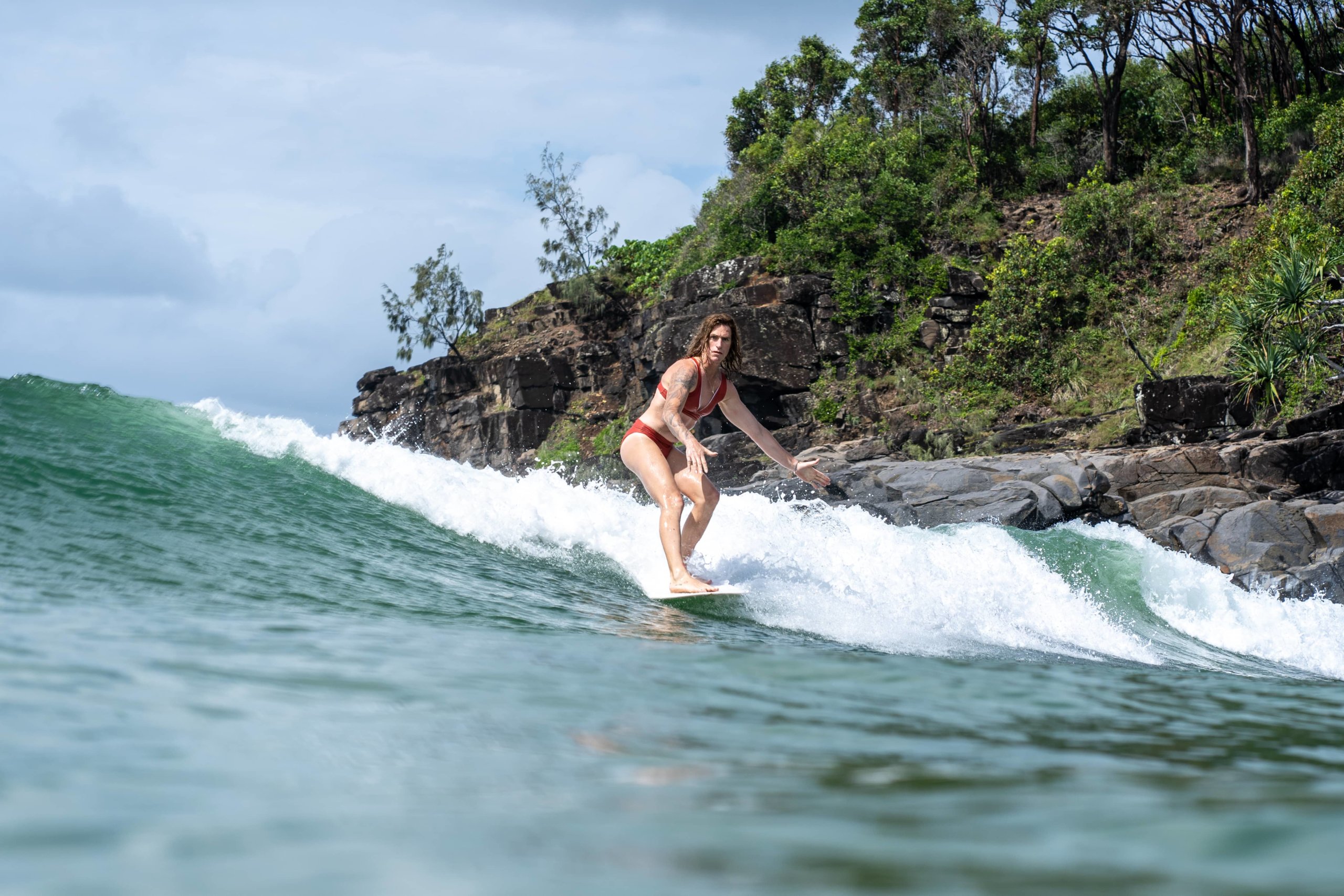
As Lowerson continues to reestablish herself in the surf community, she’s received support from multiple companies in upgrading her swimwear. Wetsuits from Atmosea and swimsuits from Zealous Swimwear and Ocean Remedy keep Lowerson feeling cute and strong in the water. By working with Lowerson, these companies hope to expand their selections to suit every water woman of every body type.
Aware of the attention that will continue to fall on her shoulders, Lowerson charges forward, committed to seizing the opportunity to set a precedent for future trans-girls.
“I definitely wouldn’t mind [doing some] advocacy and promoting visibility with youth and trans-youth wherever I go in the world. The US is in the cards in the near future. I’m looking at planning a trip to the West Coast next year. I would love to tie in some public events, just doing it for the youth. So they have someone to look up to. [I want to show them how] I put my hand up and said, can we please put a policy in place? Because I want to go and do this. It needs to be fair for everyone. I want to push across to them the message that, hey, look, I [made space for myself as I am]. What is it that you want to do? If it’s just to be seen walking down the street as you, it’s okay to do that, take that first step and let’s do it. And guess what? There’s going to be people around that will hold your hand to help you do it. What I experienced is that so much support was just hiding around the corner waiting to say, come on, take another step.”
